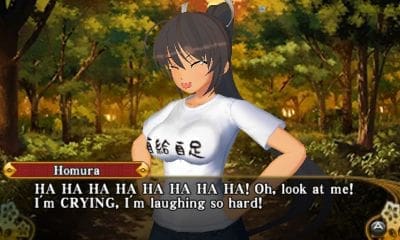It’s been a Senran Kagura-filled summer. Between wrapping up the work on Senran Kagura 2 (coming out this Tuesday the 15th!) and whipping through about 430,000 Japanese characters’ worth of text for Estival Versus, we’ve had quite a party with the cast of the series.
With Estival’s script being particularly hefty, Kris, Nick, Alyssa, and I pooled our efforts to get it edited and proofed in time. Since none of them had worked on a Senran Kagura game before, I wanted to write up a reference guide for them, mostly to familiarize them with the characters and their voices. Helpfully, I’d just recently finished editing the Senran Kagura 2 script, so I had plenty of material to build on.

In a way, introducing a writer to a new character is like meeting that character again for the first time. To properly explain who a character is, in such a way that someone else can write them with the same voice, you’ve got to take a good look at what makes the character tick. Are they calm or excitable? Is their speech style casual, colloquial, clinical, sloppy, stilted, cold, exuberant, archaic, or something else entirely? Does anything in particular make them laugh or set them off? How do they relate to each other, and if they don’t get along, why not? What do they love, what do they hate, and what do they want the most?

Of course, that’s a lot of questions, and bombarding a newcomer with assorted facts is a sure way to lose them. So before unloading all that information, it’s helpful to include a shared point of reference, an image the listener can easily picture to start getting a sense of the character. Something like, “A haughty young queen (Haruka),” or “An adorably angry terrier (Mirai),” or “A brawny, deep-voiced, foul-mouthed Skeletor (Dogen).” Once you’ve laid out that foundation, you can round out the newcomer’s image of the character with descriptions of his or her backstory, dialogue samples, visual aids, and so on.

The better the writers know each character, the stronger the bonds they can build between the characters and the audience. That’s important, because it’s a huge part of what brings fans back from game to game in a series. When it comes to Senran Kagura, the visuals can certainly attract new fans – and those visuals are in top form in Deep Crimson, with all-new animations and enhanced physics – but what keeps them around, even after they’ve gotten used to the visuals, is one part action and one part story. The girls ofSenran Kagura have fought their way through about a half-dozen games now (depending on how you count them), and each one’s done something new with their friendships, their rivalries, their goals and desires. (Even Bon Appétit. Yeah, it says it’s not canon, but…well, wait and see.)

With Senran Kagura 2, we helped chronicle new adventures for the Hanzō and Hebijo girls. True to the series’ roots, the game is equal parts heroics and hijinks; you’ll see the shinobi girls struggle with tough moral questions, and you’ll see them fight in towels over milkshakes. It’s all part of the rich, bright, surprisingly bouncy tapestry that is Senran Kagura, and we hope everyone enjoys playing it as much as we did working on it. You can pick it up next Tuesday, physically or digitally, and if you have any Burst save data on your SD card, Ikaruga’s brother, Murasame, will be playable as a bonus. (Incidentally, Burst is on sale until the 14th.)
Until we master the Path of the Shinobi,
~Ryan


